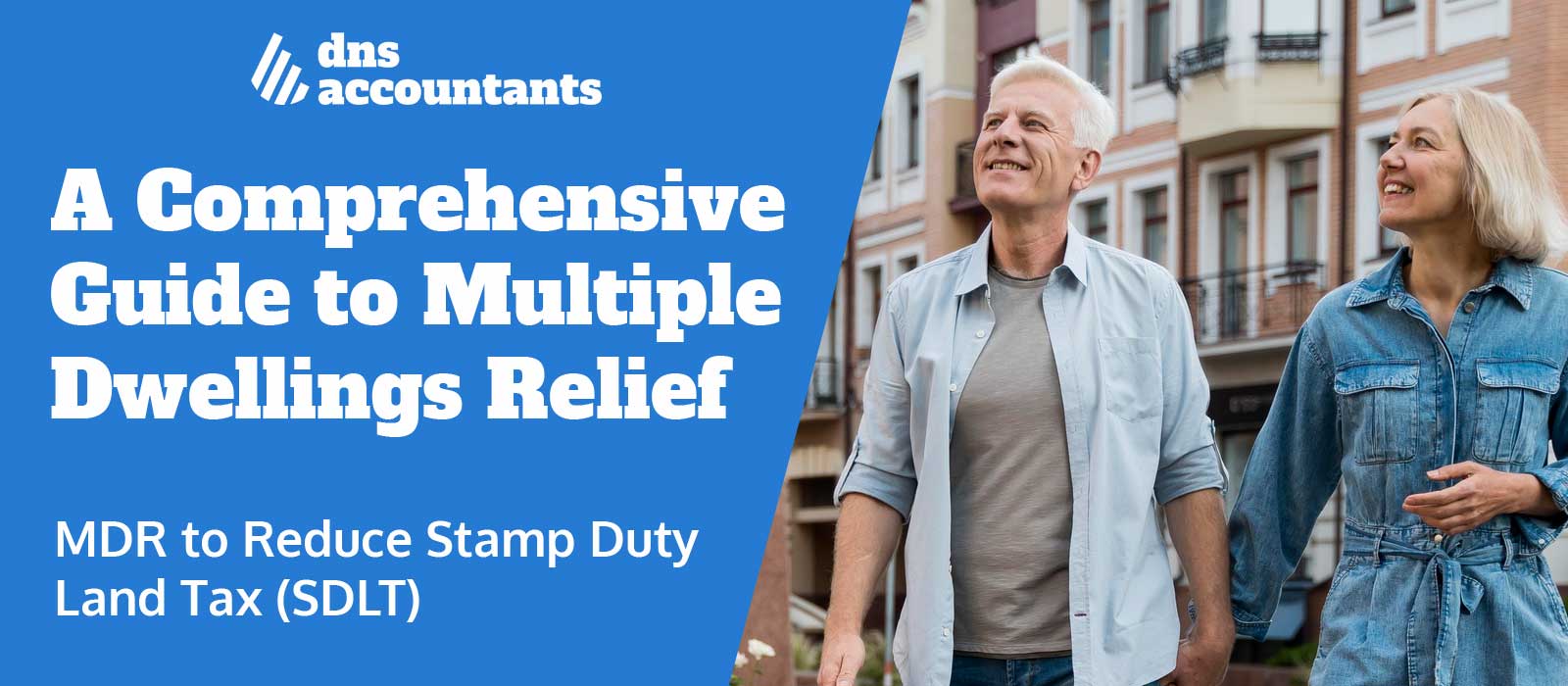
Are you looking to invest in multiple residential properties or even a mix of residential and commercial units? Did you know that there’s a tax relief designed to make such purchases more affordable? Multiple Dwellings Relief (MDR) can significantly reduce the Stamp Duty Land Tax (SDLT) payable on the acquisition of multiple dwellings, stimulating investment in residential property. In this comprehensive guide, we’ll explore the ins and outs of MDR, its eligibility criteria, types of properties that qualify for this relief, and how to claim it. We’ll also discuss linked transactions, exceptions, limitations, and the importance of seeking professional advice to maximize your potential tax savings.
Key Takeaways
- Multiple Dwellings Relief (MDR) is a beneficial tax relief for individuals purchasing additional residential properties, as it calculates Stamp Duty Land Tax (SDLT) based on the average value of multiple properties.
- MDR incentivizes property investments by reducing SDLT rates and provides savings for purchases of two or more dwellings, student accommodations, and mixed-use properties.
- Professional advice can help buyers navigate regulations to maximize their tax savings when claiming MDR while avoiding potential disputes.
Understanding Multiple Dwellings Relief (MDR)
Multiple Dwellings Relief (MDR) is a tax relief designed to reduce Stamp Duty Land Tax (SDLT) on the purchase of multiple dwellings, encouraging investment in residential property. It is available for individuals purchasing additional residential properties. The relief calculates the SDLT by applying the average value of the multiple residential properties instead of the purchase price of the individual properties or the total purchase price.
This creates the opportunity for significant tax savings, making it an enticing option for property investors and those purchasing multiple properties in linked transactions.
The Purpose of Multiple Dwellings Relief
Multiple Dwelling Relief primarily aims to reduce SDLT rates for those acquiring several dwellings in one transaction or through linked transactions. To claim multiple dwellings relief, which is also known as multiple dwelling relief, it is applied to the average price of each dwelling, rather than the total purchase price, providing substantial SDLT savings to property investors and those looking to expand their property portfolio.
Thus, MDR incentivizes residential property investments by enhancing the financial attractiveness of bulk dwelling purchases.
If you wish to reduce SDLT, Or want to arrange telephone consultation on MDR, Please call us on 03300 575 902
Eligibility for Multiple Dwellings Relief
To be eligible for MDR, one must purchase at least two dwellings or a single dwelling through a linked transaction. This means that businesses and individuals who acquire multiple residential properties in the same transaction or series of connected transactions can benefit from MDR and the associated tax savings.
Note that if a buyer purchases an additional residential property, resulting in more than six dwellings, they may be subject to non-residential stamp duty land tax rates, as it is presumed that the non residential property included is for commercial purposes.

Types of Properties Qualifying for Multiple Dwellings Relief
Various property types qualify for Multiple Dwellings Relief, including residential properties, student accommodations, and mixed-use properties. It’s essential to understand the specific criteria for each property type to ensure you can claim MDR on your property purchases.
The subsequent sections will explore further the various property types that qualify for MDR and their respective criteria.
Residential Properties
Houses, flats, and self-contained annexes can qualify for MDR. However, certain criteria must be met for annexes or ‘granny flats’ to be eligible for the relief. They must possess a bathroom and kitchen area, a separate front door, and provide a degree of privacy from the primary residence. Additionally, they should be situated on the same grounds as the main dwelling or physically connected to it, forming a separate dwelling.
Comprehending these criteria is vital when applying for MDR for residential properties.
Student Accommodation
Student accommodations, excluding halls of residence, may qualify for MDR if they meet specific criteria. For instance, residential accommodation for students, purpose-built student flats, and houses in multiple occupation (HMOs) must comprise three or more self-contained units to be eligible for the relief.
Familiarizing oneself with these criteria can enable property investors in the student accommodation sector to benefit from MDR.
Mixed-Use Properties
Mixed-use properties with both residential and non-residential elements can claim MDR for the residential portion. Examples of mixed-use properties include flats above shops or residential properties with offices. MDR can be applied to the residential component of the transaction, allowing for potential tax savings on mixed-use property purchases.
If you wish to reduce SDLT, Or want to arrange telephone consultation on MDR, Please call us on 03300 575 902
Calculating SDLT for MDR
Calculating the amount of SDLT payable under MDR involves dividing the total purchase cost by the number of dwellings and applying the appropriate tax rate. This method ensures that the SDLT is calculated based on the average value of the properties, rather than the individual purchase prices or the total purchase price, which can result in significant tax savings.
Let’s examine the basic calculation method and some example scenarios to illustrate how MDR can reduce SDLT liabilities.
Basic Calculation Method
The basic calculation method for MDR involves dividing the total purchase cost by the number of dwellings purchased. Then, the applicable tax rate is applied to the average price of the dwellings, which is determined by the prevailing main rates of Stamp Duty Land Tax (SDLT) or Land Transaction Tax (LTT) at the time of calculation. This method ensures that the SDLT payable is based on the average value of the properties, rather than the individual purchase prices or the total purchase price, resulting in potential tax savings.
Example Scenarios
Consider the following example scenario to demonstrate the savings possible with MDR:
- Investor purchases a block of four flats for £1,000,000
- Without MDR, the SDLT payable would be £43,750
- By claiming MDR and dividing the total purchase price by the number of flats, the average price of each flat would be £250,000
- The SDLT on each flat would be calculated at £2,500, resulting in a total SDLT payable of £10,000
- This represents a significant saving of £33,750 compared to not claiming MDR.
Another example involves a non-resident individual purchasing four dwellings for £950,000. They can utilize MDR to reduce their SDLT liability. By utilizing MDR, they can calculate the SDLT based on the proportion of the consideration attributable to the residential property, disregarding the non-residential consideration. This calculation assists them in paying a lower SDLT amount.

Claiming Multiple Dwellings Relief
Individuals and businesses purchasing multiple dwellings can claim MDR subject to specific rules and eligibility criteria. It is crucial to understand the process of claiming MDR and the factors that may impact eligibility.
The subsequent sections will explore who is eligible to claim MDR, the process, and the influence of linked transactions on MDR calculations.
Who Can Claim MDR?
Both individuals and businesses can claim MDR when purchasing multiple dwellings. This includes:
- Property investors
- Landlords
- Companies involved in property rental businesses
- Property development or trading companies
- Those making property available to the public.
Claiming MDR can aid these entities in realizing substantial SDLT savings, thereby enhancing the financial feasibility of purchasing multiple dwellings.
When and How to Claim MDR
MDR can be claimed through a conveyancer or professional advisor at the time of purchase or retrospectively within 12 months. When claiming MDR, it is essential to provide accurate information regarding the property transactions, including the number of dwellings, the total purchase price, and any linked transactions. A surveyor’s report or property floor plan may be required to substantiate the claim for MDR.
Adhering to the correct procedure and seeking expert advice can help property buyers maximize their MDR claim and steer clear of potential issues or conflicts.
If you wish to reduce SDLT, Or want to arrange telephone consultation on MDR, Please call us on 03300 575 902
Linked Transactions and MDR
Linked transactions involve multiple property transactions between the same buyer and seller, allowing for potential MDR savings. These transactions can include the purchase of multiple flats or apartments in a single block from a single seller, or the acquisition of several properties from the same seller in a series of connected transactions.
The following sections will discuss the definition of linked transactions and their impact on MDR calculations.
Definition of Linked Transactions
Linked transactions are multiple property transactions that occur between the same buyer and seller, or within the same company. They can include the purchase of multiple flats or apartments in a single block from a single seller, or acquisitions of several properties from the same seller in a series of connected transactions.
These transactions are relevant for SDLT purposes and can result in significant tax savings when claiming MDR.
Impact on MDR Calculations
MDR calculations for linked transactions apply the average price of each dwelling, reducing the overall SDLT due. This means that the SDLT is calculated based on the aggregated chargeable consideration of all the linked transactions, and the tax is then apportioned to each individual transaction based on their proportion of the total consideration.
This method can result in considerable SDLT savings for property buyers involved in linked transactions.
MDR Exceptions and Limitations
While MDR offers significant tax savings, there are certain exceptions and limitations that property buyers should be aware of. These may include cases where MDR doesn’t apply, as well as clawback provisions that may require the recalculation and repayment of tax if certain events occur after claiming MDR.
The subsequent sections will delve into these exceptions and limitations in greater detail.
When MDR Doesn’t Apply
MDR doesn’t apply in specific situations, such as when one dwelling has a long lease or when only plans for construction exist. Understanding these exceptions is crucial for property buyers seeking to claim MDR, as it can help avoid potential disputes or complications with tax authorities.
Clawback Provisions
Clawback provisions may require recalculation and repayment of tax if certain events occur after claiming MDR. For example, if the number of dwellings is reduced within three years following the initial transaction, a supplementary return must be completed and the tax to be paid recalculated.
Being aware of these provisions can help property buyers avoid unexpected tax liabilities and ensure compliance with MDR regulations.
MDR for Non-Residents
Non-residents can claim MDR when purchasing multiple dwellings, but they may be subject to higher tax rates due to their non-resident status.
The following sections will elaborate on the eligibility criteria for non-residents and the corresponding tax rates.
Eligibility for Non-Residents
Non-residents are eligible for MDR, but they may face higher tax rates due to their non-resident status. It’s essential for non-resident property buyers to understand the specific eligibility criteria and tax rates applicable to their situation, as this can impact their overall tax liability when claiming MDR.
Tax Rates for Non-Residents
Tax rates for non-residents claiming MDR depend on their specific circumstances and the type of property purchased. These rates can be accessed on the UK government website at https://www.gov.uk/guidance/rates-of-stamp-duty-land-tax-for-non-uk-residents.
Understanding the applicable tax rates and how they may affect their MDR claim is crucial for non-resident property buyers.
If you wish to reduce SDLT, Or want to arrange telephone consultation on MDR, Please call us on 03300 575 902
Professional Advice and Assistance
Seeking professional advice and assistance when claiming MDR can help ensure accurate calculations and maximize tax savings. Property tax accountants or conveyancers can provide expert guidance and support through the MDR claiming process, helping property buyers navigate eligibility criteria and complex regulations.
The upcoming sections will emphasize the importance of professional advice and provide guidance on locating an appropriate property tax accountant or conveyancer.
Why Seek Professional Advice?
Professional advice is recommended to navigate MDR rules, eligibility, and calculations accurately. A property tax expert or conveyancer can help ensure compliance with intricate regulations, optimize tax advantages, and avert negligence claims.
Through professional advice, property buyers can optimize their potential tax savings and circumvent potential complications or disagreements.
How to Find a Property Tax Accountant or Conveyancer
Property tax accountants or conveyancers can provide expert guidance and assistance in claiming MDR. When looking for a suitable professional, it’s essential to consider their qualifications, experience, and reputation. UK Property Accountants are authorized HMRC agents for SDLT and regularly provide advice on MDR.
Additionally, seeking recommendations from friends, family, or colleagues who have successfully claimed MDR can help identify a reliable and experienced professional.
Summary
In conclusion, Multiple Dwellings Relief offers property buyers significant tax savings when purchasing multiple dwellings. By understanding the eligibility criteria, types of properties that qualify, and how to claim MDR, property buyers can maximize their tax savings and make informed decisions when investing in residential and mixed-use properties. Furthermore, seeking professional advice from property tax accountants or conveyancers can help ensure accurate calculations and compliance with MDR regulations, ultimately leading to a successful property investment experience.
Frequently Asked Questions
What qualifies for multiple dwellings relief?
Multiple Dwellings Relief (MDR) can be claimed by individuals or companies if they purchase two or more dwellings in a single transaction, or dwellings in a scheme arrangement or series of linked transactions.
Does multiple dwellings relief apply under LTT?
Multiple dwellings relief can be claimed when purchasing more than one dwelling as part of a transaction or linked transactions, resulting in a partial relief from LTT. A return must be amended to make this claim and the relevant code 50 should be used.
Who qualifies for stamp duty relief?
Qualifying for Stamp Duty Relief is easy – first time buyers purchasing a residential property of £500,000 or less are eligible for this tax break.
What is Multiple Dwellings Relief (MDR)?
Multiple Dwellings Relief (MDR) is a tax relief that reduces the Stamp Duty Land Tax (SDLT) on purchases of multiple dwellings, to encourage investment in residential property.
How is MDR calculated?
MDR is calculated by dividing the total purchase cost by the number of dwellings and applying the applicable tax rate.
If you wish to reduce SDLT, Or want to arrange telephone consultation on MDR, Please call us on 03300 575 902


